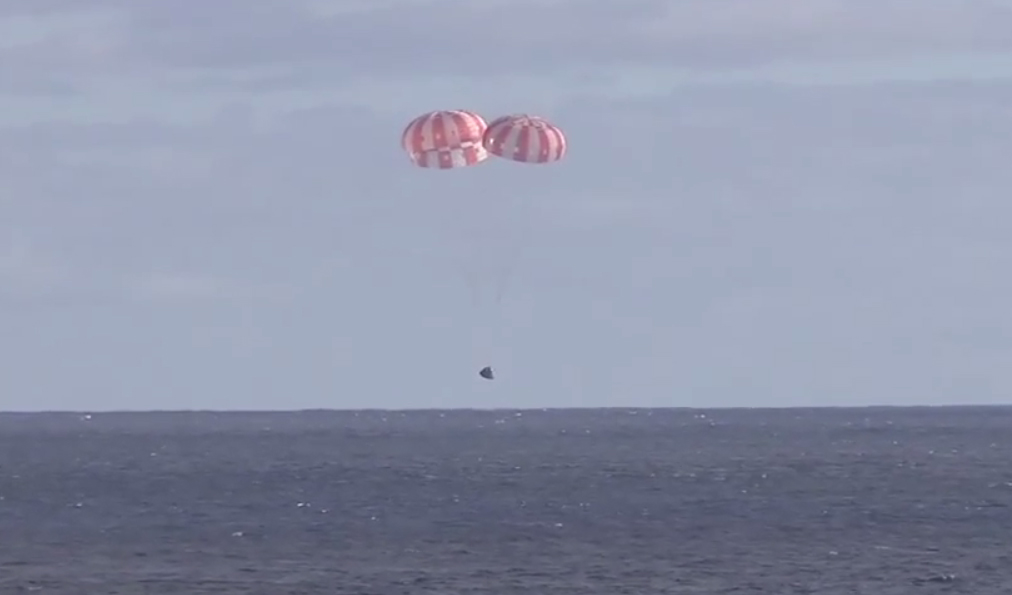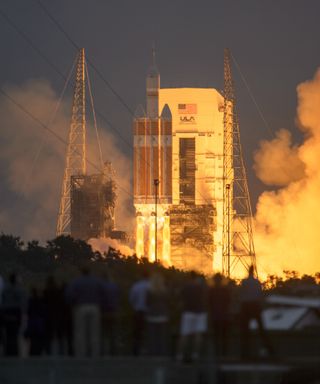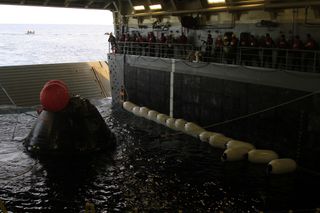NASA's Orion Spaceship Test a 'Textbook Spaceflight'

CAPE CANAVERAL, Fla. — NASA's first capsule built to take humans to Mars aced a seemingly flawless first test flight on Friday (Dec. 5), with the space agency overjoyed with the spacecraft's performance.
The Orion spacecraft appeared to function spectacularly during the risky unmanned test flight in space, and also as it came back through Earth's atmosphere and splashed down in the Pacific Ocean. Some people are comparing this historic capsule to the capsules flown during the Apollo program that brought NASA astronauts to the moon for the first time.
"It was just such a textbook spaceflight," said NASA astronaut Rex Walheim, who worked with the Orion team to develop the spacecraft. "That's what we want for our first flight." [Amazing Photos from Orion's Test Flight]

Built for NASA by Lockheed Martin, the Orion capsule launched into space atop a United Launch Alliance Delta IV Heavy rocket at 7:05 a.m. EST (1205 GMT) after a one-day launch delay. The unmanned capsule made one complete orbit of Earth before being boosted by the second stage of the Delta IV Heavy to an altitude of about 3,600 miles (5,800 kilometers) above the planet. Lockheed Martin oversaw the $370 million test flight.
People in space and on Earth were watching the test. Crewmembers on the International Space Station watched the launch from their outpost in low-Earth orbit. Orion's flight marks the first time a spacecraft built for humans has gone beyond low-Earth orbit since 1972, the year Apollo 17 launched to the moon.
"When we started at JSC [NASA's Johnson Space Center in Houston], we started with all the Apollo guys still there. So we've … now finally done something for the first time for our generation," Mike Hawes, Lockheed Martin Orion program manager, said with emotion in his voice today (Dec. 5) during a post-splashdown news conference. "It's a good day."
NASA hopes that Orion will be part of a spaceflight system that could carry humans to Mars sometime in the future.
Get the Space.com Newsletter
Breaking space news, the latest updates on rocket launches, skywatching events and more!
"We, as a species, are meant to push human presence into the solar system, and this is a first step in starting to do that," William H. Gerstenmaier, NASA's associate administrator for human exploration and operations, said during the news conference. "Thank you for getting us excited again and thinking about what it's like to be really a leader in space."
The capsule's major systems functioned well throughout the launch. Its launch abort system — built to pull astronauts out of harm's way should something malfunction during a future launch — jettisoned on time. And the spacecraft's parachutes appeared to open without issue during its descent to the Pacific.
Although the test flight appeared to go off without any serious hitch, engineers can still gather useful data from the flight, NASA officials said.
"We didn't see anything major; that's clear," Mark Geyer, NASA's Orion program manager, told Space.com during the briefing. "It looks like it flew very close to what we expected, but we have 1,200 sensors, thousands of pieces of data that we're going to get back, and I'm sure we're going to find some very interesting things about how it behaved."

NASA scientists will need to wait until they have the flight data recorded by Orion during the flight to find out how its humongous heat shield held up against the extreme heat produced when the craft re-entered Earth's atmosphere. The friction produced when the spacecraft slammed into the atmosphere going about 20,000 mph (32,000 km/h) may have created temperatures of up to 4,000 degrees Fahrenheit (2,200 degrees Celsius).
After splashdown, Orion was loaded into the well deck of the Navy's USS Anchorage ship and will be ferried to a dock in San Diego, California. From there, spacecraft will then be trucked across the country and will arrive back in Florida before Christmas.
"We've turned the corner," Walheim said. "We have a new program going now and to see us flying a vehicle that's going to be ready to take us into deep space down the road is just awesome."
Editor's Note: This story was updated to reflect a correction on Dec. 7 at 10 a.m. EST. Orion is not the first spacecraft built for astronauts to go beyond the orbit of the International Space Station in 40 years as the article originally stated. Space shuttle missions to the Hubble Space Telescope went beyond the station's orbit.
Follow Miriam Kramer @mirikramer. Follow us @Spacedotcom, Facebook and Google+. Original article on Space.com.
Join our Space Forums to keep talking space on the latest missions, night sky and more! And if you have a news tip, correction or comment, let us know at: community@space.com.

Miriam Kramer joined Space.com as a Staff Writer in December 2012. Since then, she has floated in weightlessness on a zero-gravity flight, felt the pull of 4-Gs in a trainer aircraft and watched rockets soar into space from Florida and Virginia. She also served as Space.com's lead space entertainment reporter, and enjoys all aspects of space news, astronomy and commercial spaceflight. Miriam has also presented space stories during live interviews with Fox News and other TV and radio outlets. She originally hails from Knoxville, Tennessee where she and her family would take trips to dark spots on the outskirts of town to watch meteor showers every year. She loves to travel and one day hopes to see the northern lights in person. Miriam is currently a space reporter with Axios, writing the Axios Space newsletter. You can follow Miriam on Twitter.